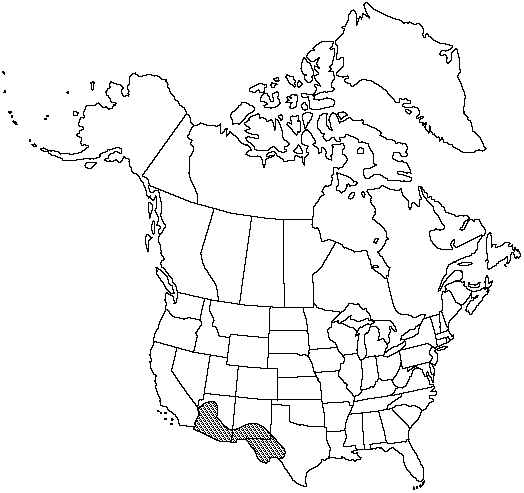Cheilanthes villosa
Proc. Biol. Soc. Wash. 31: 142. 1918.
Stems compact, 4–8 mm diam.; scales mostly bicolored, with broad, well-defined, dark, central stripe and narrow, light-brown margins, linear-lanceolate, straight to slightly contorted, loosely appressed, persistent. Leaves clustered, 7–30 cm; vernation noncircinate. Petiole usually dark-brown, rounded adaxially. Blade oblong-lanceolate to ovate, 3–4-pinnate at base, 1.5–5 cm wide; rachis rounded adaxially, with scattered filiform to lanceolate scales, not pubescent. Pinnae not articulate, dark color of stalk continuing into pinna base, basal pair not conspicuously larger than adjacent pair, usually equilateral, appearing villous adaxially. Costae green adaxially for most of length; abaxial scales multiseriate, ovate to lanceolate, shallowly cordate at base, often with overlapping basal lobes, conspicuous, the largest 0.4–1.5 mm wide, strongly imbricate, often concealing ultimate segments, erose-dentate, not ciliate. Ultimate segments round to oval, beadlike, the largest 1–2 mm, abaxially nearly glabrous except for a few coarse hairs, adaxially villous with coarse, unbranched hairs. False indusia marginal to obscurely inframarginal, slightly differentiated, 0.05–0.25 mm wide. Sori ± continuous around segment margins. Sporangia containing 32 spores. n = 2n = 90, apogamous.
Phenology: Sporulating summer–fall.
Habitat: Cliffs and rocky slopes, usually on limestone
Elevation: 400–2200 m
Distribution

Ariz., N.Mex., Tex., n Mexico
Discussion
Cheilanthes villosa is an apogamous triploid of unknown parentage. Although there are reports of hybridization between C. villosa and C. eatonii (D. B. Lellinger 1985), recent gene exchange is unlikely because both taxa are apogamous in North America. Morphologically intermediate specimens (tentatively called C. pinkavii in T. Reeves 1979) are included here in C. eatonii, pending further study and valid publication of Reeve's epithet.
Selected References
None.
Lower Taxa
"wide" is not a number.